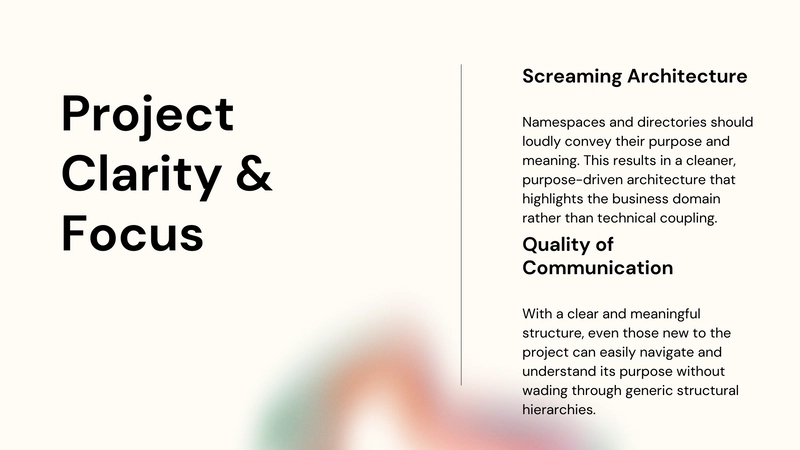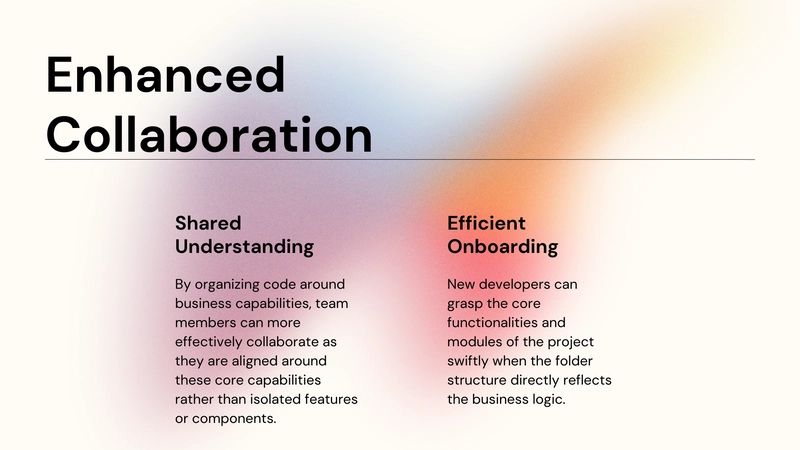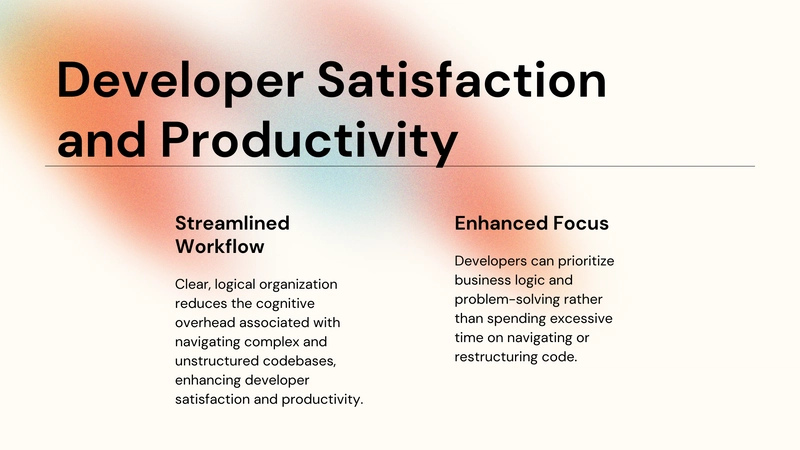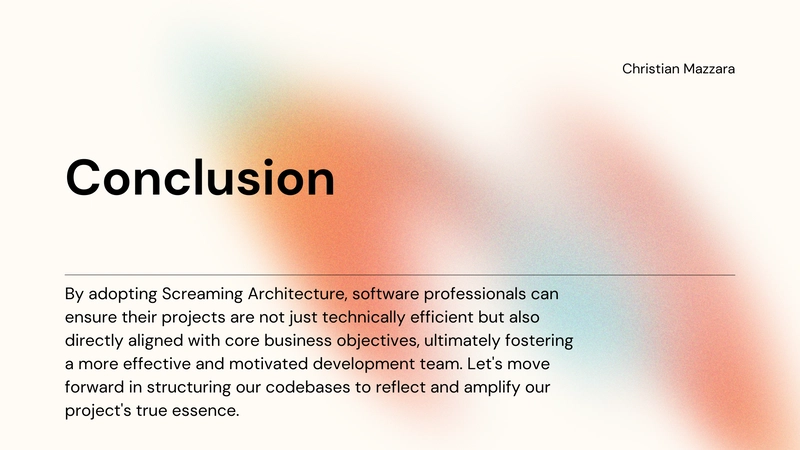Embracing the Screaming Architecture paradigm plays a crucial role in how one structures and navigates a software project. I personally find this approach more attractive and better organized. Here’s a brief overview of how this approach contrasts with traditional practices and the impact it can have on development processes: Project Clarity & Focus Screaming Architecture: Namespaces and directories should loudly convey their purpose and meaning. This results in a cleaner, purpose-driven architecture that highlights the business domain rather than technical coupling. Quality of Communication: With a clear and meaningful structure, even those new to the project can easily navigate and understand its purpose without wading through generic structural hierarchies. Enhanced Collaboration Shared Understanding: By organizing code around business capabilities, team members can more effectively collaborate as they are aligned around these core capabilities rather than isolated features or components. Efficient Onboarding: New developers can grasp the core functionalities and modules of the project swiftly when the folder structure directly reflects the business logic. Scalability and Maintainability Clear Expansion Pathways: Adding new features or modules becomes intuitive when the architecture already provides a clear roadmap of where new code should reside based on its purpose. Reduced Technical Debt: A well-organized structure can prevent overlap and duplication, ensuring changes are integrated seamlessly without the chaos of navigating nested, generic hierarchies. Developer Satisfaction and Productivity Streamlined Workflow: Clear, logical organization reduces the cognitive overhead associated with navigating complex and unstructured codebases, enhancing developer satisfaction and productivity. Enhanced Focus: Developers can prioritize business logic and problem-solving rather than spending excessive time on navigating or restructuring code. Conclusion By adopting Screaming Architecture, software professionals can ensure their projects are not just technically efficient but also directly aligned with core business objectives, ultimately fostering a more effective and motivated development team. Let's move forward in structuring our codebases to reflect and amplify our project's true essence. LinkedIn
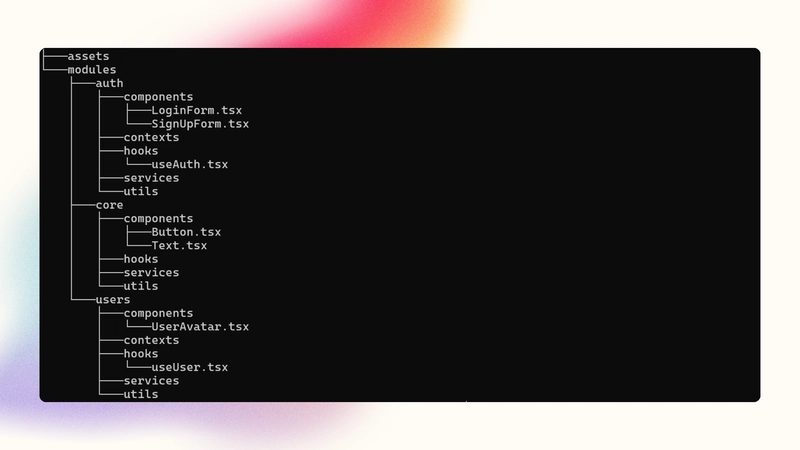
Embracing the Screaming Architecture paradigm plays a crucial role in how one structures and navigates a software project.
I personally find this approach more attractive and better organized. Here’s a brief overview of how this approach contrasts with traditional practices and the impact it can have on development processes:
Project Clarity & Focus
Screaming Architecture:
Namespaces and directories should loudly convey their purpose and meaning. This results in a cleaner, purpose-driven architecture that highlights the business domain rather than technical coupling.Quality of Communication:
With a clear and meaningful structure, even those new to the project can easily navigate and understand its purpose without wading through generic structural hierarchies.
Enhanced Collaboration
Shared Understanding:
By organizing code around business capabilities, team members can more effectively collaborate as they are aligned around these core capabilities rather than isolated features or components.Efficient Onboarding:
New developers can grasp the core functionalities and modules of the project swiftly when the folder structure directly reflects the business logic.
Scalability and Maintainability
Clear Expansion Pathways:
Adding new features or modules becomes intuitive when the architecture already provides a clear roadmap of where new code should reside based on its purpose.Reduced Technical Debt:
A well-organized structure can prevent overlap and duplication, ensuring changes are integrated seamlessly without the chaos of navigating nested, generic hierarchies.
Developer Satisfaction and Productivity
Streamlined Workflow:
Clear, logical organization reduces the cognitive overhead associated with navigating complex and unstructured codebases, enhancing developer satisfaction and productivity.Enhanced Focus:
Developers can prioritize business logic and problem-solving rather than spending excessive time on navigating or restructuring code.
Conclusion
By adopting Screaming Architecture, software professionals can ensure their projects are not just technically efficient but also directly aligned with core business objectives, ultimately fostering a more effective and motivated development team. Let's move forward in structuring our codebases to reflect and amplify our project's true essence.












































































































































































![[The AI Show Episode 142]: ChatGPT’s New Image Generator, Studio Ghibli Craze and Backlash, Gemini 2.5, OpenAI Academy, 4o Updates, Vibe Marketing & xAI Acquires X](https://www.marketingaiinstitute.com/hubfs/ep%20142%20cover.png)




























































































































![[DEALS] The Premium Learn to Code Certification Bundle (97% off) & Other Deals Up To 98% Off – Offers End Soon!](https://www.javacodegeeks.com/wp-content/uploads/2012/12/jcg-logo.jpg)

![From drop-out to software architect with Jason Lengstorf [Podcast #167]](https://cdn.hashnode.com/res/hashnode/image/upload/v1743796461357/f3d19cd7-e6f5-4d7c-8bfc-eb974bc8da68.png?#)








































































































.png?#)


































_Christophe_Coat_Alamy.jpg?#)


.webp?#)





































































































![Apple Considers Delaying Smart Home Hub Until 2026 [Gurman]](https://www.iclarified.com/images/news/96946/96946/96946-640.jpg)
![iPhone 17 Pro Won't Feature Two-Toned Back [Gurman]](https://www.iclarified.com/images/news/96944/96944/96944-640.jpg)
![Tariffs Threaten Apple's $999 iPhone Price Point in the U.S. [Gurman]](https://www.iclarified.com/images/news/96943/96943/96943-640.jpg)

































































































































